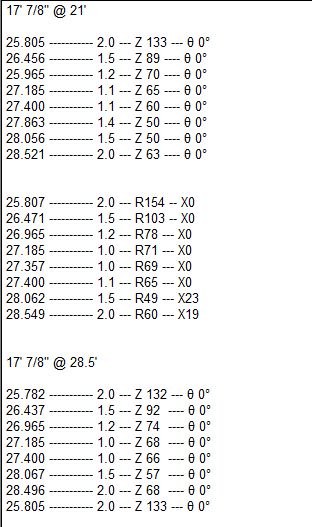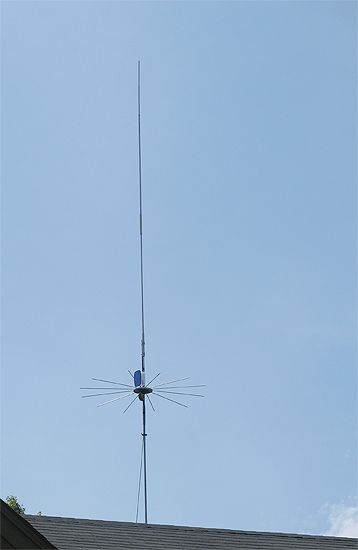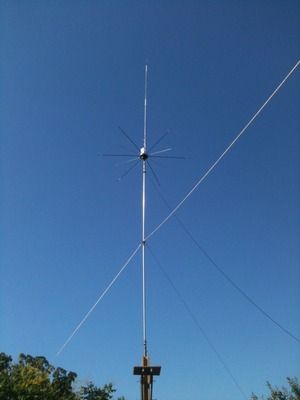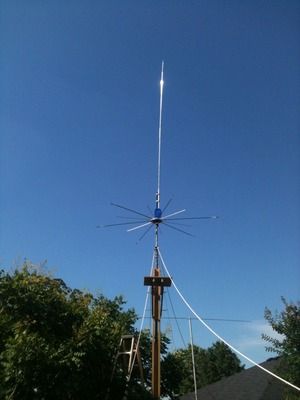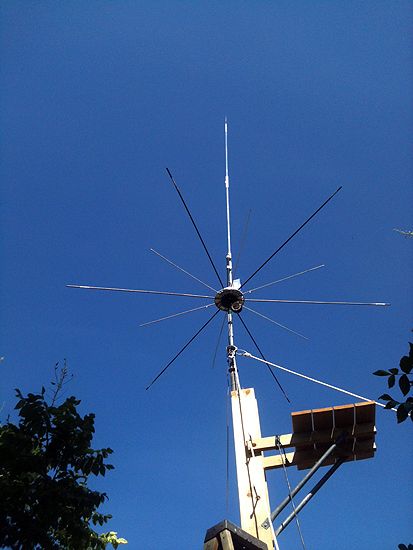As I had told some I was to do, I once again went back to the antenna.
I had suspicions regarding the way things were going with the MFJ-259b readings.
I did several things in order to be sure of my controls on this antenna.
1. I took a continuity tester and sampled different ones of the radials. What I found was that some were not well connected
in the system. I had a fix.
2. I replaced 6 of the 12 three feet long radials with 6 fifty-nine inch radials. Common wisdom states that the radials
need to be at least 1/8 wavelength to be effective. I now had 6 x 3' and 6 x 5' radials for my GP. To cure the issue with
some of the radials not having good grind to the system I ran an additional wire around the entire thing and checked
continuity. All of them were now firmly in the system.
3. I now attached my analyzer directly to the feedpoint using two female threaded couplers and a single double male
threaded coupler. This gave me the reach through the GP to the SO-239 on the antenna. This was done standing on the tunng
platform of my tower with the antenna feedpoint at 21' height above the ground.
4. I then went into the shack and took a series of analyzer readings through the feedline at antenna FP height 21'
5. Lastly, I raised the antenna FP to 37' and took another series of analyzer readings from the shack end of the feedline.
Results below.
I measured the bandwidth as the matching network had been set before modifications to the radials at 21' height:
SWR ---------- Freq ------ X ---- 0
2.0 --------- 28.766 ---- 55 ---- 18
1.5 --------- 28.358 ---- 49 ---- 23
1.1 --------- 27.549 ---- 57 ---- 1
1.2 --------- 27.405 ---- 59 ---- 5
1.3 --------- 27.185 ---- 64 ---- 11
1.5 --------- 26.951 ---- 68 ---- 19
2.0 --------- 26.455 ---- 85 ---- 17
Moved the tap point on the coil to try to center on 27.400
2.0 --------- 28.449 ---- 65 ---- 18
1.5 --------- 28.035 ---- 48 ---- 22
1.0 --------- 27.395 ---- 59 ---- 0
1.1 --------- 27.185 ---- 63 ---- 0
1.5 --------- 26.727 ---- 73 ---- 14
2.0 --------- 26.324 ---- 85 ---- 22
I had the center where I wanted it, but I didn't want to have
the bandwidth so low, so I adjusted the variable aluminum flat bar capacitor.
2.0 --------- 28.907 ---- 55 ---- 18
1.5 --------- 28.444 ---- 48 ---- 22
1.2 --------- 28.027 ---- 49 ---- 9
1.3 --------- 27.406 ---- 60 ---- 10
1.5 --------- 27.086 ---- 67 ---- 20
2.0 --------- 26.554 ---- 86 ---- 17
Results from the feedline in the Shack at 21' height.
2.0 --------- 29.552 ---- 25 ---- 4
1.5 --------- 28.652 ---- 52 ---- 23
1.1 --------- 27.405 ---- 50 ---- 7
1.1 --------- 27.185 ---- 46 ---- 7
1.2 --------- 26.965 ---- 45 ---- 9
1.5 --------- 26.359 ---- 61 ---- 22
2.0 --------- 25.586 ---- 136 ---- 0
Results from the shack end of feedline at 37' height
2.0 --------- 29.572 ---- 25 ---- 4
1.5 --------- 28.699 ---- 49 ---- 23
1.1 --------- 27.405 ---- 50 ---- 8
1.1 --------- 27.185 ---- 45 ---- 7
1.2 --------- 26.965 ---- 44 ---- 9
1.5 --------- 26.351 ---- 62 ---- 22
2.0 --------- 25.518 ---- 130 --- 0

